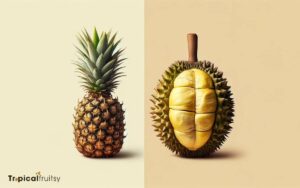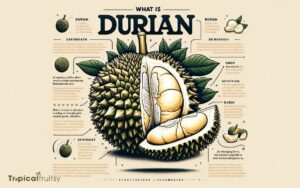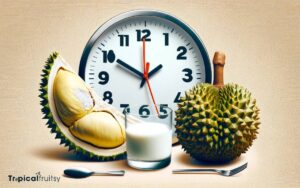What Does a Durian Tree Look Like? Nature’s Marvel!
The Durian tree is a majestic tropical plant from the Durio genus, famed for its large, spiky, and notably odorous fruit.
These trees can tower up to 50 meters in their natural habitat but are often shorter when cultivated.
A durian tree features a straight trunk with rough bark, supporting a dense canopy of shiny, oblong leaves, and produces sizeable white to yellow flowers followed by its unique fruit.
Durian trees are characterized by several distinctive features:
These attributes make the durian tree an easily recognizable species in the regions it is native to, such as Southeast Asia.
The durian tree is an iconic symbol of Southeast Asia, celebrated for its unique fruit with a notorious scent.
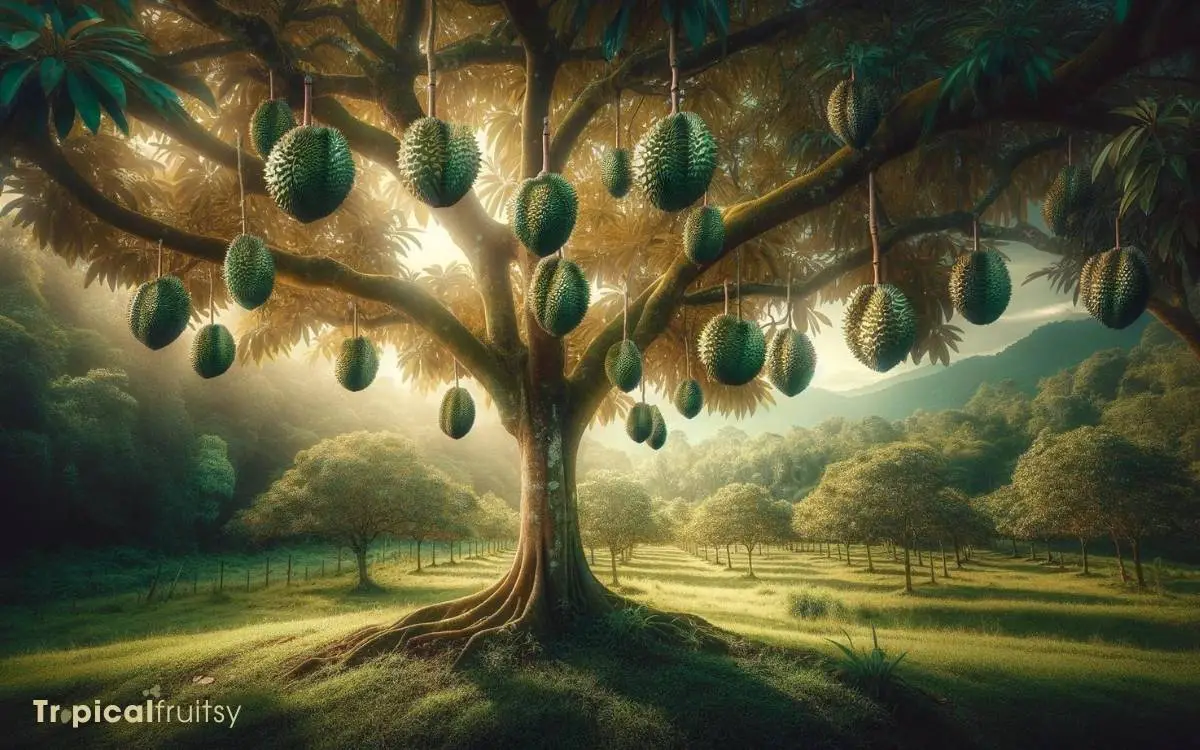
Key Takeaway
Characteristics of a Durian Tree: A Tropical Delight
| Feature | Description |
|---|---|
| Scientific Name | Durio |
| Tree Height | Up to 50 meters in the wild, shorter when cultivated |
| Trunk | Straight, cylindrical, rough, brown bark |
| Leaves | Evergreen, oblong, leathery, up to 25 cm long |
| Flowers | Large, white to yellowish |
| Fruit | Large, spiky husk, strong aroma |
| Preferred Climate | Humid, tropical climates |
Durian Tree Origins
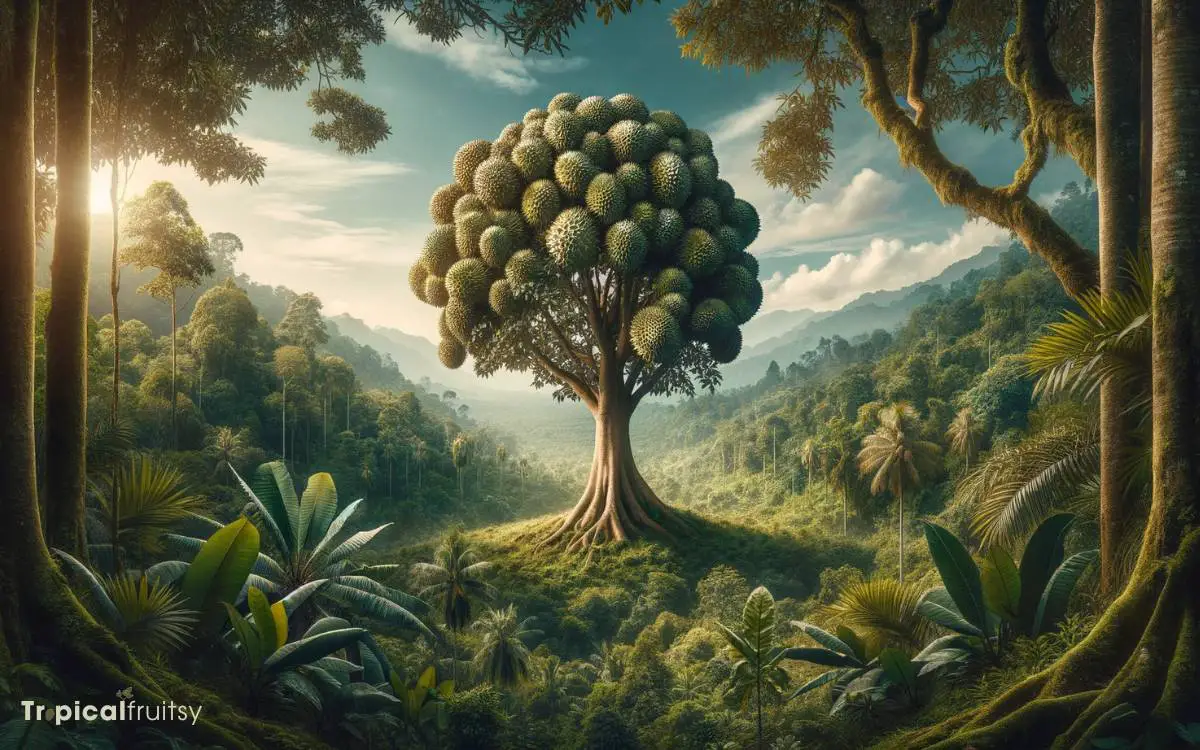
The durian tree, native to Southeast Asia, is a tropical species belonging to the genus Durio, with approximately 30 recognized species.
These species exhibit a significant degree of genetic diversity, a testament to their evolutionary adaptability within the region’s varied ecological niches.
Durio zibethinus, the most commercially cultivated species, is characterized by its formidable size, reaching up to 50 meters in height in optimal conditions.
The durian tree’s morphology includes evergreen, elliptic leaves with an acuminate tip, contributing to its dense canopy.
Floral biology is specialized; the tree produces large, pungent flowers which are primarily pollinated by bats.
The phylogenetic lineage of Durio suggests an ancient origin in Gondwana, followed by dispersal and speciation influenced by geographical and climatic changes.
Size and Structure
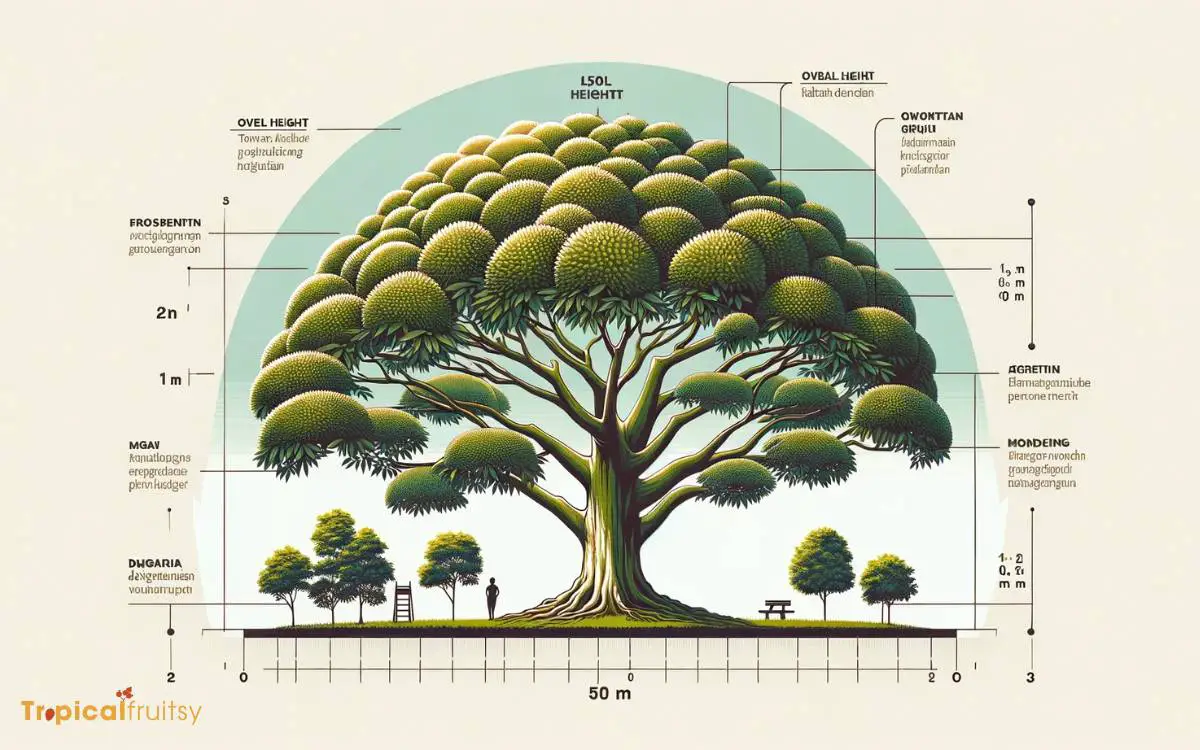
The Durio species, known for producing the durian fruit, exhibits considerable variability in its physical dimensions, with a typical height range spanning 25 to 50 meters upon maturity.
The structural integrity of the tree is reinforced by its robust, erect trunk, which bifurcates into a well-defined branching pattern that supports the heavy fruit load.
An examination of the branching patterns reveals a pyramidal or conical canopy architecture, critical for optimizing light interception and enhancing photosynthetic efficiency.
Height Range
Within its tropical habitat, a durian tree typically reaches a height of 25 to 50 meters. It displays a majestic and sturdy structure characterized by its erect trunk and a pyramidal or umbrella-like canopy.
This arboreal giant possesses a robust, cylindrical bole that may extend upwards of 40 centimeters in diameter. This provides the necessary support to sustain its considerable height and the expansive canopy.
The durian’s aerial architecture is a function of both genetic determinants and environmental factors. The interplay of these factors dictates the phenotypic expression of its vertical growth.
Vigorous apical dominance ensures a consistent upward trajectory, facilitating the tree’s access to sunlight in dense forest canopies.
This discussion on the durian’s impressive stature sets the stage for an examination of its branching patterns, which are integral to its overall morphology.
Branching Patterns
Durian trees exhibit a distinctive branching pattern characterized by one or two primary branches that extend almost horizontally from the trunk, giving rise to numerous secondary branches that support the dense foliage and heavy fruit clusters.
These scaffold branches are integral to the tree’s architecture, typically demonstrating sympodial growth where the terminal bud ceases growth and a lateral bud takes over, leading to a zigzag pattern.
Such a structure is crucial for distributing the weight of the durians, which can be substantial.
The tertiary branches further subdivide, optimizing sunlight interception and photosynthetic efficiency. The robustness of the branches is paramount, as they must withstand the load of the durians, which can each weigh several kilograms.
The tree has evolved this branching morphology as a survival adaptation to ensure both physical support and maximal reproductive output.
Bark and Trunk Characteristics
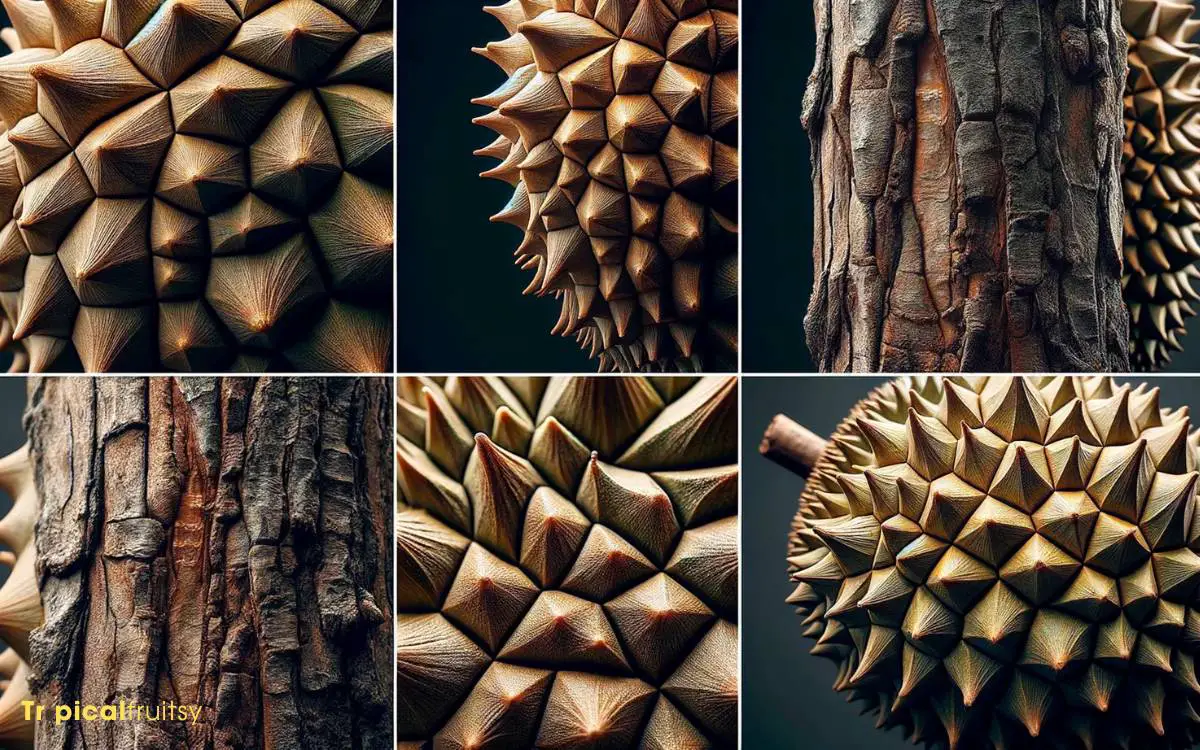
The bark of the durian tree exhibits a distinct texture that is pertinent to its identification and classification within the genus Durio.
An analysis of the trunk girth provides quantitative data on the tree’s maturity and potential yield capacity.
Accurate characterization of these features is essential for both botanical research and practical applications in durian cultivation.
Bark Texture
A durian tree’s bark is typically brownish-grey with a somewhat rough and scaly texture, providing a unique tactile aspect to the tree’s sturdy trunk.
The texture is not merely an aesthetic characteristic; it is indicative of the tree’s age and health.
A detailed analysis of the bark reveals several pertinent features:
- Thickness: The periderm layer is substantially thick, offering robust protection against physical damage and pathogenic organisms.
- Rigidity: The surface is not pliable, signifying a lignified and suberized structure, which is essential for water retention and defense.
- Scaling: Irregular, plate-like scales are a manifestation of the periodic exfoliation of the outer bark, facilitating the tree’s growth.
- Color Variation: The hue variations in the bark may correlate with exposure to environmental factors and the presence of lenticels for gas exchange.
Trunk Girth Measurement
Measuring the girth of a durian tree’s trunk provides valuable insight into its maturity and overall vigor. Mature trees typically exhibit substantial diameters that reflect their advanced age and structural stability.
The trunk girth, quantified as the circumference at breast height (CBH), is a critical dendrometric parameter used by arborists and foresters to appraise the tree’s biomass and potential timber yield.
To ensure accuracy, measurements are taken at approximately 1.3 meters above the ground, circumventing irregular basal flare.
Durian trees (Durio spp.), in their prime, display robust trunks with girths that can exceed two meters. This indicates a well-established root system and the ability to bear the heavy fruit load.
The bark texture, combined with trunk dimensions, is utilized in age approximation and health assessments.
Foliage Description
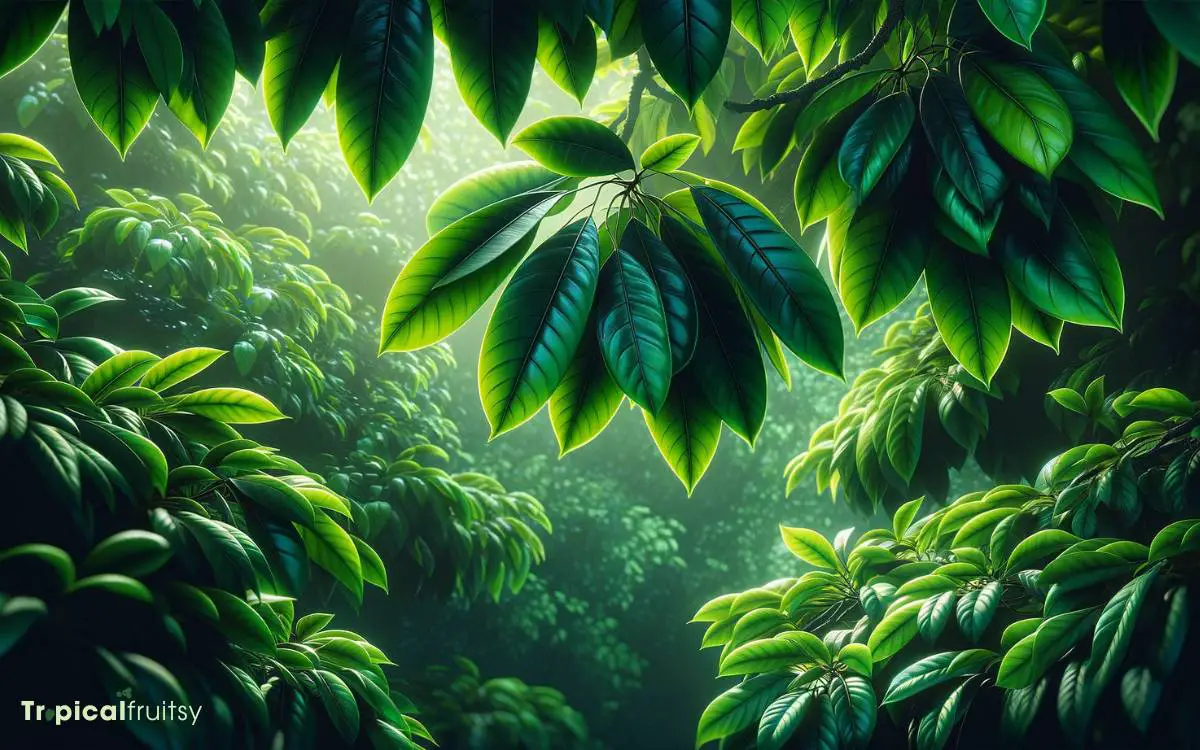
Amid the robust branches of the durian tree, elongated leaves of vibrant green emerge, each typically ranging from 15 to 25 centimeters in length.
The foliage of the durian tree is characterized by several distinct features:
- Leaf Shape: The leaves are oblong to lanceolate, with a pointed tip and a broad base that tapers gradually.
- Texture: The dorsal surface is glossy, while the ventral surface exhibits a matte finish, with a leathery texture endemic to the species.
- Veination: A prominent midrib extends the full length of the leaf, with secondary veins arching toward the leaf margins.
- Arrangement: Leaves are alternatively arranged, creating a staggered pattern that optimizes sunlight capture.
This verdant canopy sets the stage for the tree’s reproductive phase, transitioning seamlessly into a discussion of the durian’s unique flowering habits.
Flowering Habits
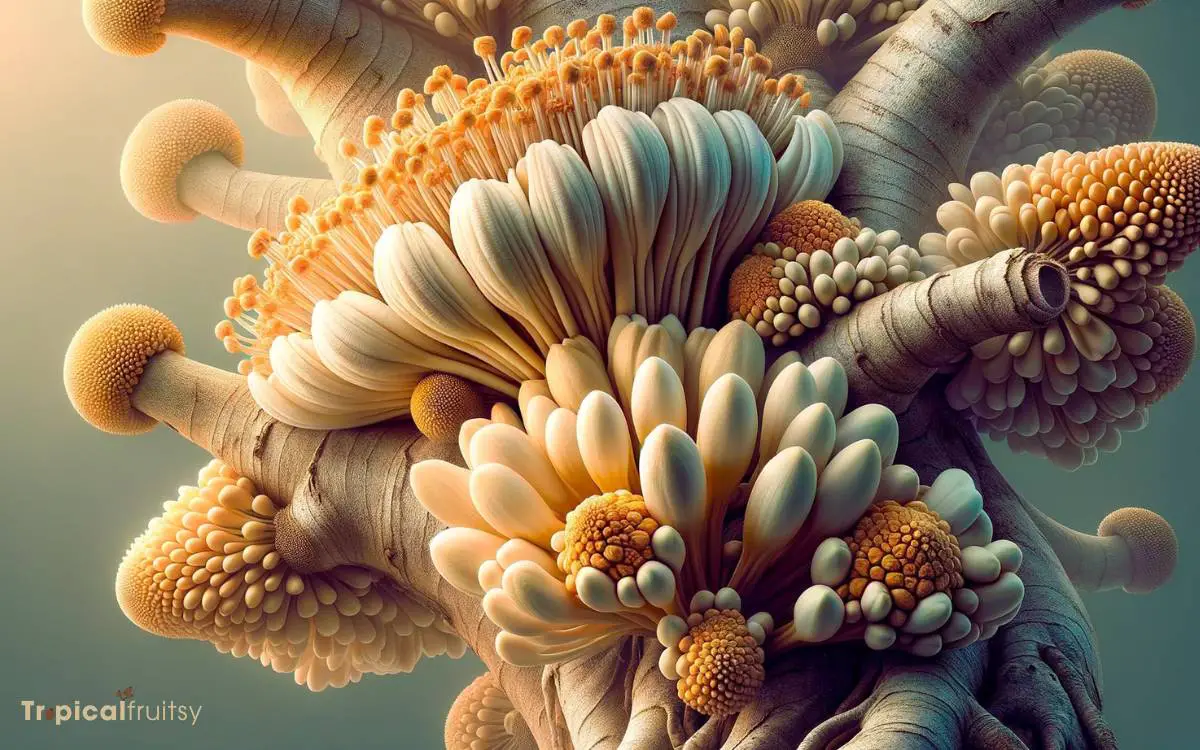
Durian trees typically flower once annually, producing large, white to yellowish blossoms that emit a potent aroma.
These aromatic inflorescences are pivotal for attracting specific pollinators, such as bats and certain species of birds and insects, which are integral to the fertilization process.
The flowering phase is contingent upon climatic conditions, with optimal blooming occurring in environments that exhibit a distinct dry period followed by moderate rainfall.
The phenological cycle of the durian tree exhibits a synchronous flowering pattern, where the blossoms open predominantly at night, a trait that coincides with the activity patterns of their nocturnal pollinators.
This nocturnal anthesis ensures the effective transfer of pollen and sets the stage for the subsequent fruit bearing process.
Fruit Bearing Process
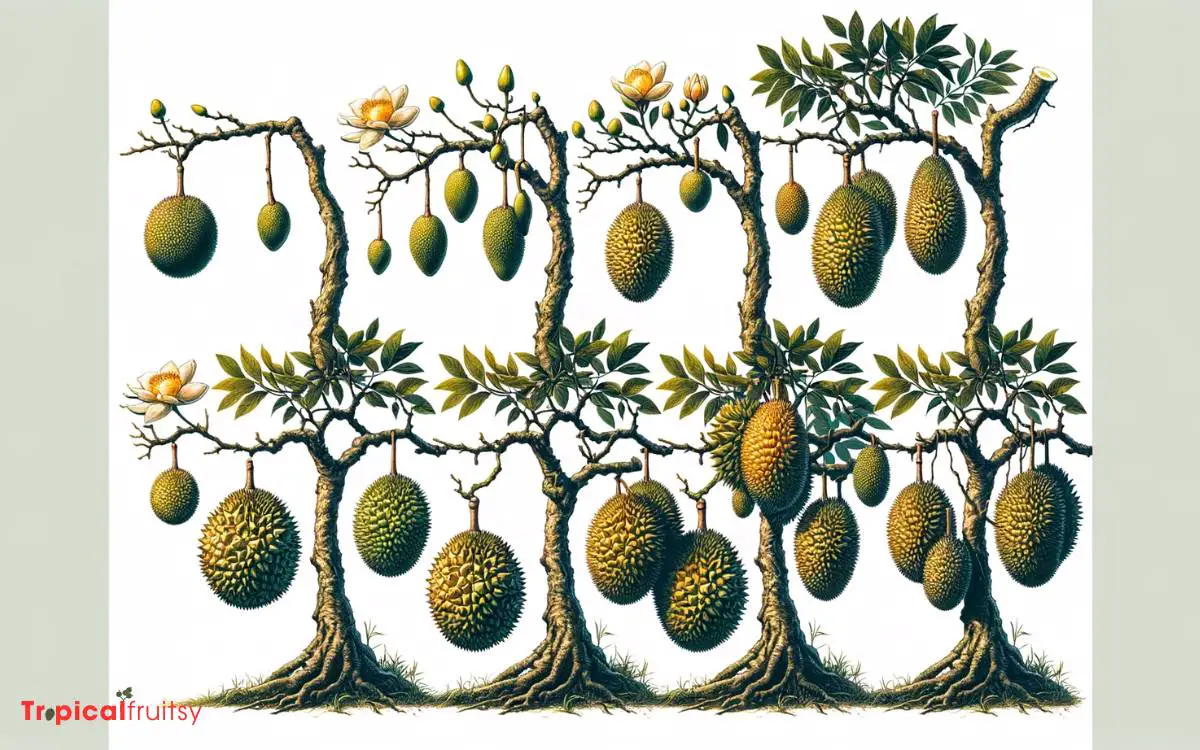
Following the flowering period, a durian tree enters the fruit bearing process when the fertilized flowers develop into large, spiky fruits that are renowned for their distinctive smell and taste.
This process is intricate and can be detailed as follows:
- Pollination: Typically carried out by bats and other nocturnal pollinators, it is essential for the transition from flower to fruit.
- Fruit Development: Over several months, the fertilized ovary swells, forming a tough, thorn-covered rind, encapsulating the edible flesh.
- Maturation: The biochemical processes within the fruit advance, converting complex sugars and influencing the unique flavor profile.
- Abcission: The mature durian fruit detaches from the branch due to the weakening of the peduncle, often indicating ripeness and readiness for consumption.
Understanding these sequential stages provides insight into the durian’s complex life cycle and agricultural significance.
Growth Environment
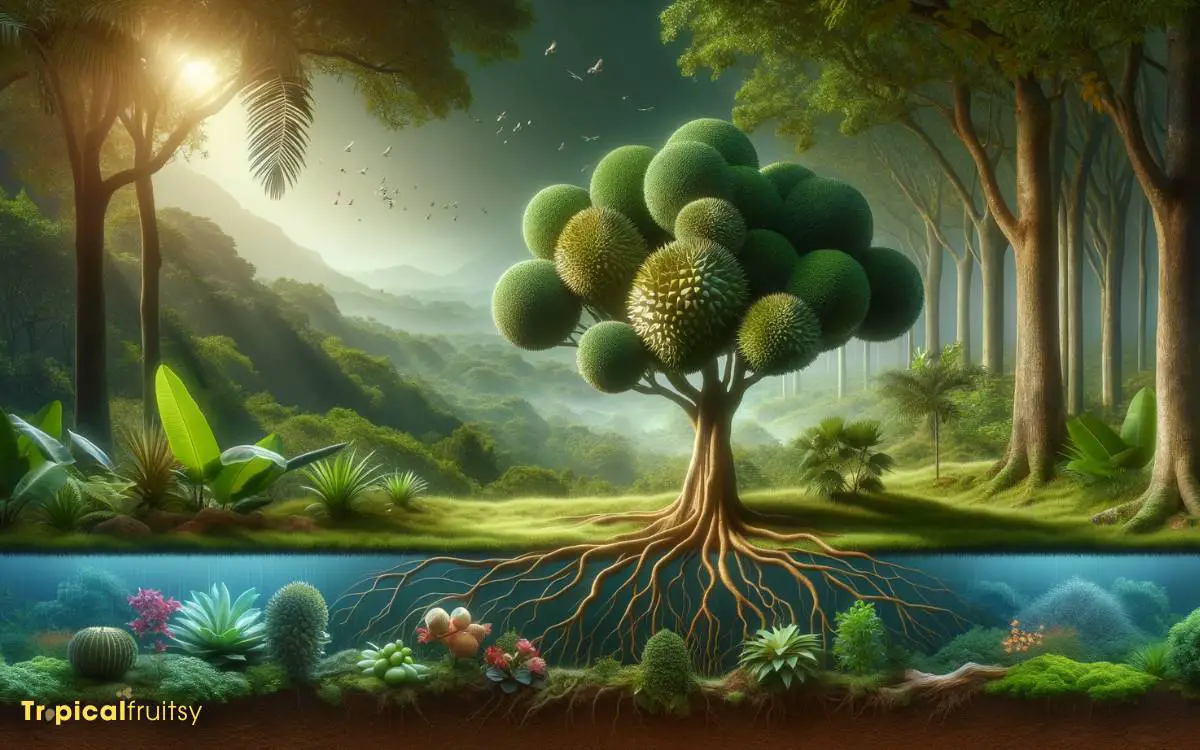
While the durian tree thrives in its fruit-bearing process, it requires a specific growth environment characterized by tropical climates with abundant rainfall and consistently warm temperatures to support its development.
Optimal growth conditions necessitate a mean annual temperature range of 22 to 30 degrees Celsius and a high humidity level, typically above 80%.
Soil composition plays a crucial role; loamy, well-drained soils with high organic matter content and a pH ranging from 6 to 7 offer the most conducive substrate for root expansion and nutrient uptake.
Furthermore, durian trees demand ample solar exposure to synthesize the necessary photosynthates for growth and fruit production. Inadequate sunlight can lead to poor yield and inferior fruit quality.
The microclimate should also be relatively sheltered from strong winds to prevent physical damage to the tree’s structure.
Seasonal Changes and Care
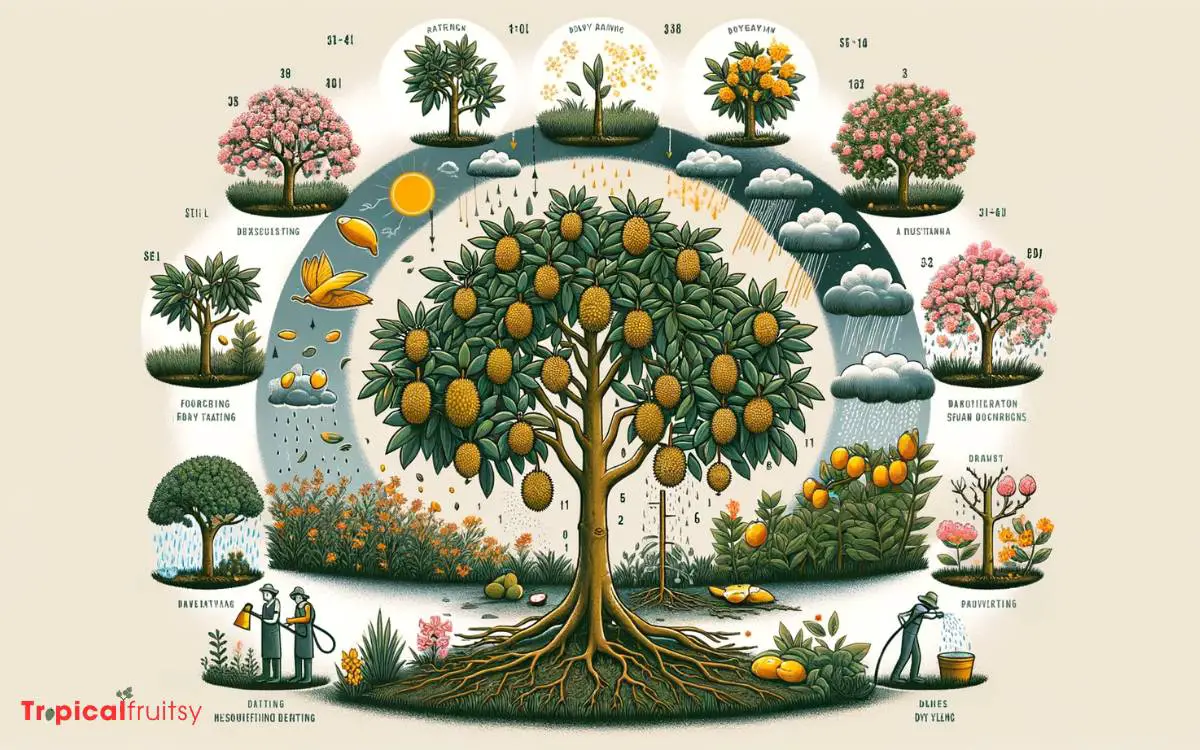
Throughout the year, a durian tree’s care regimen must be attentively adjusted to align with the seasonal variations typical of its tropical habitat.
The maintenance of this species demands a thorough understanding of its growth cycle and environmental requirements.
To ensure optimal health and fruit production, the following seasonal care steps are critical:
- Wet Season Preparation: Enhance drainage systems to prevent root saturation, while ensuring adequate water supply for increased metabolic activity.
- Dry Season Management: Implement irrigation strategies to mitigate hydric stress, and monitor for signs of wilting or leaf scorch.
- Fertilization Schedule: Apply high-potassium fertilizers pre-flowering and nitrogen-rich blends post-harvest to promote growth and fruit set.
- Pest and Disease Vigilance: Increase surveillance for infestations and fungal infections, adapting treatments to seasonal prevalence and lifecycle stages of common pathogens.
Conclusion
In summary, the Durio zibethinus, commonly known as the durian tree, stands as a testament to tropical arboriculture.
It can grow up to 50 meters tall and has a trunk cloaked in reddish-brown bark. Its evergreen leaves are oblong and leathery, and its flowers bloom at night, giving rise to the iconic, thorn-covered fruit.
This species thrives in equatorial climates, which requires specific agroforestry techniques for its propagation.
The durian tree is like a botanical king crowned with formidable fruits, reigning supreme in Southeast Asian forests.

